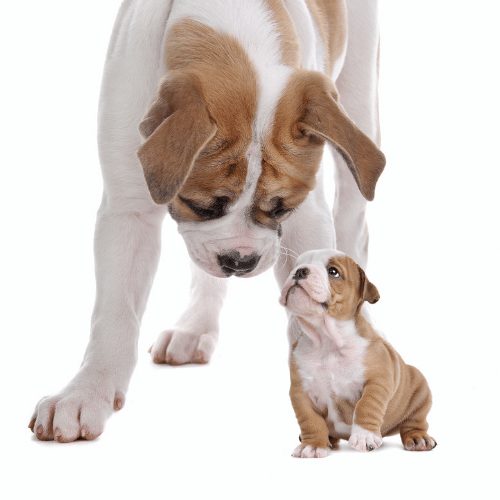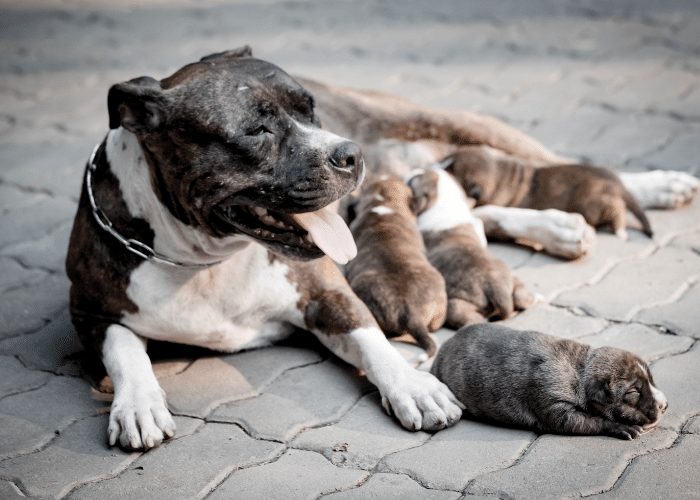Puppy Growth Chart Calculator
May 30, 2021 2022-08-16 17:20Puppy Growth Chart Calculator
How big will my puppy get? This is a question that every dog owner has. Whether you decided for a pure-bred dog or a mixed breed, there is a lot of variation in size, even within dogs of the same litter!
Our puppy weight and growth calculator
We got the most accurate puppy growth calculator on the internet!
Table of Contents

How our puppy weight calculator works
Most puppy weight calculators do not take into account the characteristic growth curve that dogs (and all living beings for that matter) have. Typical puppy weight calculators assume that a dog grows linear until he is 1 year old, at which age he abruptly stops.
The truth is quite different. Luckily, there are a number of scientific studies that explore in detail how exactly dogs grow.
Our growth and weight calculator is based on the following scientific publications:
Growth standard charts for monitoring bodyweight in dogs of different sizes
This study is an analysis of growth and age data of over 6 million dogs.
Body-Weight Changes during Growth in Puppies of Different Breeds
Body size, inbreeding, and lifespan in domestic dogs
As far as we know, this is the only weight prediction calculator that is based on actual scientific growth data specific to individual breeds and the most accurate puppy weight calculator on the internet.

Does the smallest puppy in a litter stay the smallest?
Until pure-bred puppies are about 6-8 weeks old, their weight is not yet a prediction of their adult size. Factors such as uterine placement (where they were in the mom’s tummy) will determine their birth weight. As they grow throughout the two months of their life, the biggest pup of the litter might become one of the smaller ones, and the runt might catch up!
This might be different for mixed-breed puppies as there can be a lot of size variation within one litter.
Is a dog full grown at 6 months?
No dog breed is done growing at months old. In general though, small dog breeds mature much faster than large breeds. A lap dog like the Chihuahua will be closer to his adult size at 6 months old than a very large breed.
Keep in mind that even though your small dog might look like an adult dog already at 6 months old, they are still very much puppies and need a lot of patience and training.
Is a dog full grown at 10 months?
Small breeds such as Cavachons or Shorkies are nearly fully grown at 10 months old. Large breeds are not – in fact, some very large dogs such as Mastiffs or King Shepherds can grow and fill out until after their second birthday.
At what age does a dog reach its full height?
Small dog breeds reach their full height by their first birthday. Large dog breeds can grow in height until they are about 16 months old. But even after that age they will continue to “fill out”. Their chest can become wider (especially if they have not yet been spayed or neutered) and they become more muscular.
If you own a long-coated breed you will notice that your dog’s coat continues to grow and become more voluminous. This might give your dog the appearance of growing considerable, but it is all fluff!
Do dogs eat less when they stop growing?
Many dogs eat a lot while they are growing, especially giant breeds. Their calorie needs decrease as they reach their final size. You will probably need to adjust your dog’s food once he reaches his adult size and weight. (Just like a growing teenager eats more than most adults!)
If you notice that your dog gains weight and becomes chunky somewhere around 18 months of age, the reason is probably that he does not need the amount of food anymore he required as a growing puppy.
At what age do puppies grow the most?
Puppies grow the fastest during their first week of life. They usually double their birth weight by the time they are 7 days old. While they continue growing rapidly afterwards, they do slow down a bit.
The same is true for all other species: The growth rate is the highest when they have just been born. This is because they quickly need to gain weight to be strong and healthy.
If a puppy or a whole litter of puppies struggles to gain weight quickly in the first few days, it is crucial to take them to a vet. Perhaps the mother is not producing enough milk, and the pups need some bottle feeding in addition to nursing.
At times, puppies can also have congenital defects that cause slow weight gain.

Breed-specific growth and weight calculators for puppies
Below you can find our breed-specific growth calculators:


